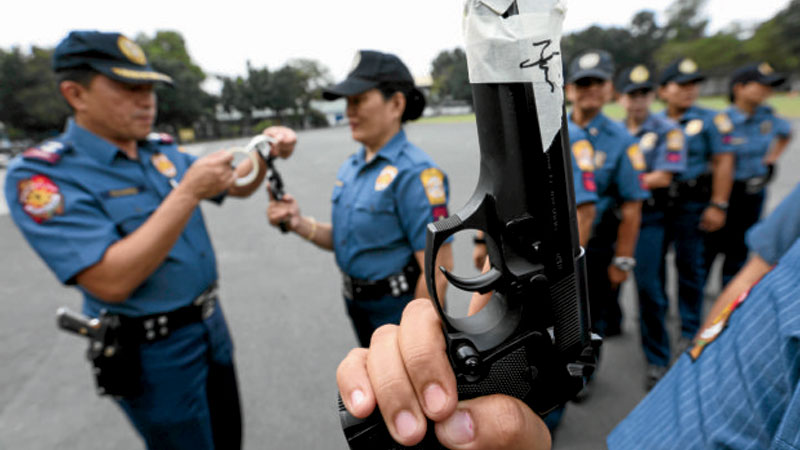
GUN CHECK The muzzles of guns of police officers in past years had been taped to ensure that they do not fire their weapons indiscriminately during the holiday season. —NIÑO JESUS ORBETA
Cases of indiscriminate firing of guns to greet the New Year nearly doubled to 23 cases from Dec. 16, 2015 to Jan. 2, 2017, compared to just 11 in the same period a year earlier, police said on Tuesday, insisting the higher figure was mainly due to more complaints from the public.
The number of indiscriminate firing cases rose to four between 5 p.m. of Dec. 31 and to 5 a.m. of Jan. 1 from just one in the same period a year earlier, or a 300 percent rise, according to Chief Supt. Camilo Pancratius Cascolan, the head of the Directorate for Investigation and Detective Management of the Philippine National Police.
Cascolan attributed the sharp rise to the fact that the public promptly reported to the PNP more incidents of people firing their guns.
But he said the number of stray bullet cases dropped to just 12, from Dec. 16, 2016 to Jan. 2, 2017, from 55 cases reported from Dec. 16, 2015 to Jan. 2, 2016.
“[Our records] show that there were incidents on illegal discharge of firearms that were not reported last year,” Cascolan told reporters.
“What the PNP chief would want to convey [is that] maximum deployment and community involvement have actually decreased the stray bullet incidents,” he added.
“The main reason why illegal discharge reports have increased is due to the community support.”
Appeal for prayers
Statements, pictures and videos of alleged indiscriminate firing and illegal discharge incidents on social media networks were investigated by the police, reported to the headquarters, and included in the tallies for Dec. 31-Jan. 1 and Dec. 16-Jan. 2., he stressed.
The family of the teenage girl believed to be a stray bullet victim from Malabon City appealed to the public to pray for her speedy recovery.
“We are calling on our fellow Filipinos to help us pray for our daughter. Please pray that my daughter will continue to live,” said Emilyn Villanueva’s father, Emil.
Villanueva remains in deep coma and has shown “no signs of recovery,” according to the health department.
Health Secretary Paulyn Jean Ubial has maintained that the victim sustained her injuries from a stray bullet and not from deliberate shooting as claimed by police authorities.
Stricter gun control
The founder of the Gunless Society of the Philippines stressed that the government must impose stricter gun control measures to deter cases of indiscriminate firing and gun-related violence in general.
“Our government should be also hard on guns, not just on illegal drugs because they feed each other. The existence of guns not only facilitates acts of gun violence but might even be an incentive,” Reynaldo Pacheco told the Inquirer.
He noted that police statistics for the Dec. 16 to Jan. 2 period showed that 22 out of 28 suspects arrested or wanted for indiscriminate firing were civilians.
“Stray bullet fatalities eventually get forgotten. Our government has been reduced to counting statistics on stray bullets and indiscriminate firing each year, but has done nothing to stop the proliferation of firearms—loose or otherwise—through the years,” Pacheco said.
Pacheco’s group has been advocating a total ban on all firearms and insists that only policemen in uniform and on duty should be the ones allowed to carry firearms on the streets.
More reports of injuries
The Department of Health spokesperson, Dr. Eric Tayag, said on Tuesday that fireworks-related injuries had continued to slowly climb to 581 cases, with additional delayed reports of new cases.
But even with the increase in the number of cases, the report noted that the figure was still 36 percent lower than the five-year (2011-2015) average, and 36 percent lower compared with the same period last year.
Ubial said she “expects that surge of fireworks-related injuries will be reported after Jan. 1, 2017” due to delayed reports.
But the overall figure remains significantly lower compared to 2016, she insisted.
“We would like to reiterate that the reference of comparison between 2015 and 2016 data will be disclosed on Jan. 6, 2017, once the surveillance report has been consolidated,” Ubial told the Inquirer. —WITH REPORTS FROM TINA G. SANTOS AND LEILA B. SALAVERRIA